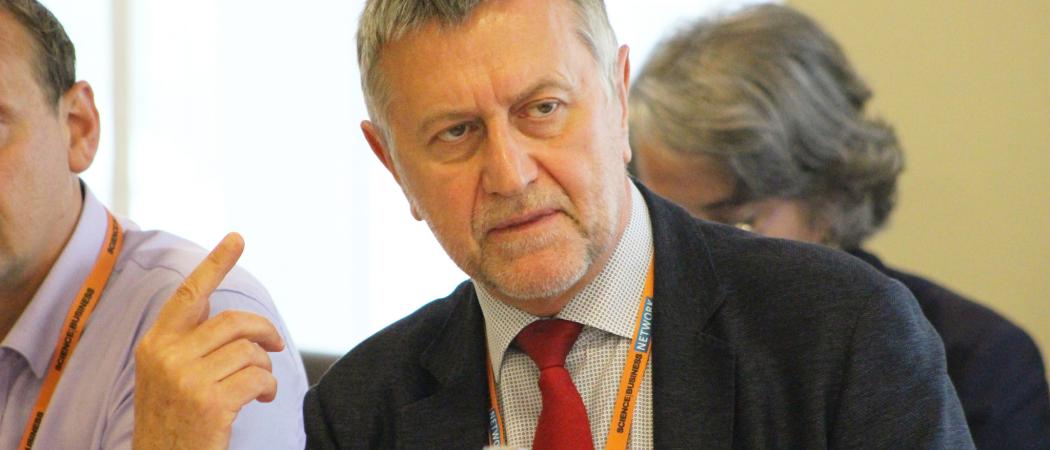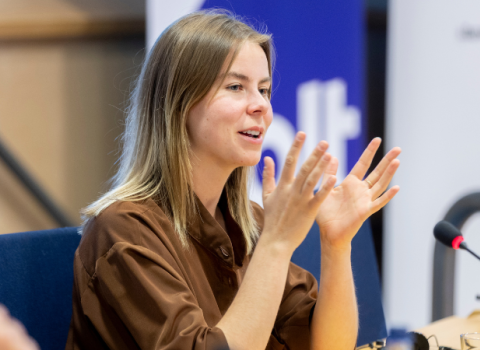For Structural Funds, official tells Science|Business conference, EU will make it easier to work across regions and with Horizon Europe

Rudolf Niessler, director for smart and sustainable growth, DG Regio, European Commission.
The European Union plans to change its rules on regional development funding for innovation to enable much broader innovation support from its Structural Funds, including digitisation, economic transition and related skills. The changes will come in during the EU’s next seven-year budget cycle, starting 2021, according to Rudolf Niessler, director for smart and sustainable growth at the Commission’s regional-development department.
At the core of the new policy for the European Regional Development Funds, Niessler said, will be the “smart specialisation” strategies, requiring regions to develop a plan for focusing investment on sectors in which they are most competitive. Niessler said that due to the introduction of smart specialisation strategies as a pre-condition for funding in 2014, there was already some progress: there are already “pockets of scientific and technological excellence emerging in less developed countries”. The challenge is now to translate this into innovation in enterprises to generate jobs and growth and to ensure that all EU regions will benefit from this.
Smart specialisation works best, he said, in “dynamic diverse cities” where a rising number of businesses are growing up close to universities. Problems remain, though, with most of the Union’s 276 regions investing less than 3 per cent of GDP in research and development. In 50 regions, said Niessler, the figure is below 0.5 per cent.
New rules
Niessler, talking at a Science|Business conference in Brussels June 5th, also indicated that the next round of the European Semester – the Commission’s annual assessment of how member states are implementing structural reforms – will refer to investment needs in member states and how these could be addressed through regional development policy. That might also indicate necessary investments in research and innovation. Such orientations for the investments will be enshrined in partnership agreements and operational programmes of the funds.
Also at the conference, Pieter de Jong from Friesland-based innovation hub Wetsus, called for the next EU budget to improve inter-regional collaboration, including across borders, urging an end to “the ‘this is our cake and we will eat it mentality’” over regional funding.
That’s already happening, said Niessler: regions “will in the future be able to collaborate via regional funding on any relevant project in Europe,” he said. In the proposed regulations for the future Structural Funds, the requirement to spend Structural Funds inside one’s own territory has been removed entirely, but such activities will need to contribute to the objectives of the relevant national or regional programme.
An entirely new provision will allow countries and regions to participate more in other EU programmes by transferring a small part of their ERDF allocations to that programme. Like this, for instance, a region can become a partner in the supercomputing partnership to be funded from the Commission’s planned Digital Europe Programme.
Another option is the “Seal of Excellence” approach; this involves proposed Horizon Europe projects that get a high score but no funding. The Seal is, in essence, a certificate that recommends the projects to other funding bodies, including Structural Funds. This approach will be expanded to a number of other programmes, such as Digital Europe and the Single Market Programme. The funding of Seal of Excellence projects will also be simplified, as the ERDF may give the same aid intensity as under Horizon or Digital Europe. “We have resolved this problem"and the relevant state aid rules will be adjusted accordingly, Niessler said.
The EIT and the regions
Niessler’s message on cross-programme synergies was welcomed by Peter Olesen, chairman of the governing board of the European Institute of Innovation and Technology (EIT). “We’d like to do more with [regions],” he said, adding: “We connect into the innovation hubs through the local people.”
“We want to be a much more central player in the [regional] landscape,” said Olesen, highlighting the EIT’s role in spreading good practice, facilitating access to funding and helping regions to accelerate.
Finance is a priority. For Olesen, the big challenge is how to design public support that incentivises private investment. “There are too many silos, too many boxes,” he said. At the moment the system in Europe is “fragmented on several levels”, he said. “We really lack an innovation strategy for Europe.”
But when it comes to finding investment there do seem to be regional variations. Jacques De Chilly from Lyon Metropolis reported that startups in the French city are having no problems finding financing: “The money is there.”
Sandra Rey, CEO of Paris-based energy startup Glowee, a venture supported by the EIT, said: “You need to find money very quickly at the beginning. It takes eight to nine months to get money from private investors – during which you are not working on your product.”
More hubs?
Does Europe need more innovation hubs? On that point, opinions at the conference differed.
“We have to implant [innovation] hotspots in non-innovation areas,” said Niessler, if we are to deal with economic and social disparities in Europe. But there is no quick fix: it has to be done by building up an innovative ecosystem through “a sustained (effort) involving all the actors over a medium time frame”.
Innovation hubs can work well, but more important is that they gain critical mass, said Lyon’s De Chilly. “We need to get companies to connect and use the capacity of the [existing] innovation hubs.” The focus needs to be on SMEs, he said, “where 80 per cent of new jobs are created”.
“I’m not sure we really need more hubs,” said Maria Alajõe, director of innovation and business relations at Tallinn University of Technology. For her, what is needed is “all the ingredients of an innovative ecosystem”.
And you don’t even need a university to create a hub, said de Jong from the Wetsus hub, which has 240 companies, some from abroad. “Our region has no university but was able to turn that into a plus,” he said.
Meanwhile, Rey from Glowee professed that her company was not actually part of an innovation hub, at least not in a formal sense. Glowee had benefited from the Grenoble-based EIT InnoEnergy hub, though without being a member. “As a company I feel very far from these [policy] things, and I have no idea about them,” she said.
Light up the scoreboard
One thing that might help is to give greater prominence and detail for the Commission’s European Innovation Scoreboard. Take the indications from the Scoreboard and develop them into a dashboard that would allow regions to compare themselves with others at greater levels of detail, urged Heinrich Klopp from NBank, Lower Saxony.
Rather than have centrally dictated targets, said Klopp, the idea would be for regions to design their own preferred indicators and targets. And that, he said, should be coupled with the dissemination of good practice. “There is nothing as good as a regional result that has succeeded,” he said. “We have to learn from each other.





 A unique international forum for public research organisations and companies to connect their external engagement with strategic interests around their R&D system.
A unique international forum for public research organisations and companies to connect their external engagement with strategic interests around their R&D system.